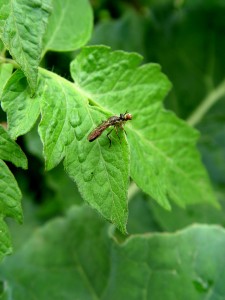The Case for More Plants
July 19th, 2011
We can always use more reasons to plant more plants.

Not many predators are going to move into a non-diverse landscape like this one with nothing other than lawn and meatlballed yews.
I ran into one of the best yet in a talk last Friday by Dr. Michael Raupp at the annual Woody Plant Conference at Scott Arboretum.
He says that adding more plants is good for bug control in the yard.
Raupp, a University of Maryland entomologist and bug consultant for the TV show “Bones,” has actually counted bugs in plant nuts’ yards vs. your typical lawn-and-yew barrenscape.
He found that populations of predator bugs are way higher in diverse settings.
What happens is that the predators are then able to do a much better job of keeping the pests under control without us even realizing it.
That answers the question of how comes your azaleas and dwarf spruce seem to get picked on by lace bugs and mites while the gardening nut next door never seems to have to spray anything.

Diverse landscapes like this one, planted by Larry Lenig in Hampden Twp., are loaded with predators and unlikely to run into bug problems.
Raupp says diverse landscapes “become reservoirs of beneficial insects. You often get three times more bang for your buck in a complex habitat that’s loaded with natural enemies.”
So rather than bone up on the latest bug-killers, his recommendation is to get more plant variety in your yard.
He’s a fan of native plants since those are the ones most familiar to and most useful to our natural predators. But he says an even bigger goal is to work on getting more of all kinds of flowering plants in the landscape – especially if you can rig it so that there’s always something in flower throughout the whole season.
In cases where you really do need to control a pest bug that’s getting out of control or threatening to kill or maim a favorite plant, Raupp advises looking for one of the newest insecticides that have passed the U.S. Environmental Protection Agency’s reduced-risk registration program.
These new products are much more focused and therefore less likely to harm non-target bees, butterflies, birds and us as well as cause much less environmental disruption.
Raupp actually named some of his specific favorites. So if you’re looking to battle bugs and want do so as safely as possible, here’s his list:
- Most any horticultural oil or insecticidal soap.
- Acelepryn (chlorantraniliprole) for Japanese beetles, caterpillars, gypsy moths, bagworms, borers, leafminers and lace bugs. “This one is so safe it doesn’t even to carry a caution label,” Raupp says.
- Floramite (bifenozate) and Shuttle (acequinocyl) for various mites.
- Endeavor (pymetrozine) for aphids and whiteflies.
- Entrust or Capt. Jack’s Deadbug Brew (Spinosad) for caterpillars and sawfly larvae.
- Confirm (tebufenozide) for gypsy moths, bagworms, webworms, spruce budworms and pine tip moths.
Most of these are so new that you won’t yet find them at the garden center. They’re becoming more available in catalogs and through online vendors, though.
Raupp also likes microbials or biological controls – packaged living organisms that eat or infect pests.
The best known older one is Bt (Bacillus thuringiensis), a bacterium that targets only caterpillars.
Raupp says a newer strain of Bt (Bt tenebrionis) is effective at controlling the elm and viburnum leaf beetles.
Naturalis-O (Beauvaria bassiana) is a “friendly fungus” that controls mites and a few other insects.
And for controlling beetle grubs in the lawn, Raupp suggests a type of microscopic roundworm called a nematode that’s introduced into the lawn. The two main helpers: Heterorhabditis and Steinernema.
Once these nematodes knock back their favorite pest, they usually move onto other soil-dwelling pests and control those as well. Raupp says some nematodes will feed on up to 200 different kinds of insects – rivaling the landscape-plant diet of Japanese beetles.
Again, nematodes aren’t widely available in garden centers since they’re not well known and fairly perishable. But almost all organic mail-order companies carry them.
Raupp has a fascinating web site, by the way, that’s a must if you’re at all interested in bugs in the landscape. Check it out at www.bugoftheweek.com.
I’ll have more on what “The Bug Guy” had to say in my Patriot-News garden column coming up Aug. 4.








